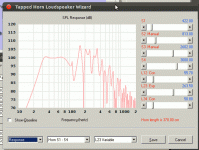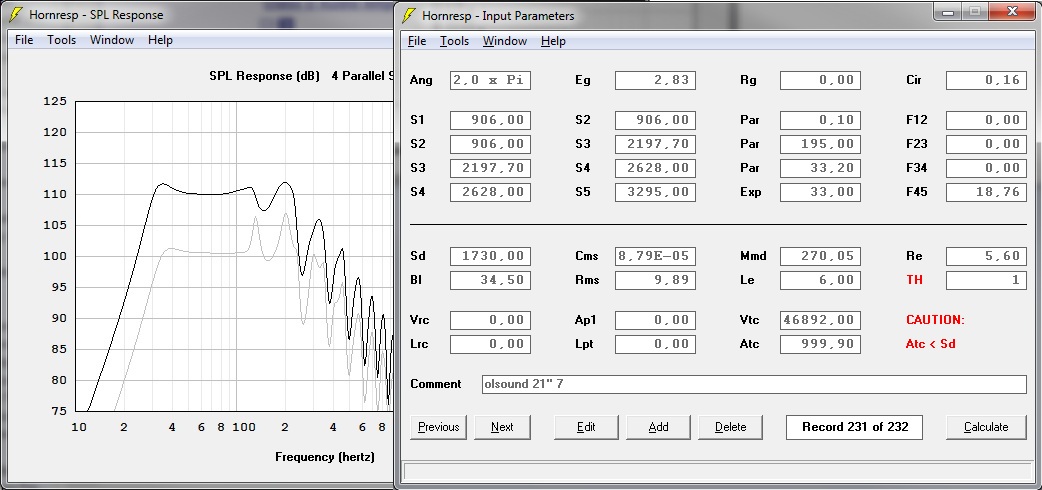Actually it's not that difficult if you use Extended LF PA drivers with their -3dB point above their Fs.
Hmm...
If you've found a way to break Hoffmann's Iron Law, I'll be interested in how you managed to do it.
A 2 cu ft 2nd order sealed box with an F3 of 30hz can only be 0.18% efficient (84.55dB).
A 2 cu ft 4th order vented box with an F3 of 30hz can only be 0.36% efficient (87.56dB).
A 2 cu ft 6th order vented box with an F3 of 30hz can only be 0.90% efficient (91.54dB).
Cabinet size is a cube function of the cut-off frequency, so:
40hz box size is 1x
32hz box size is 2x
25hz box size is 4x
20hz box size is 8x
If you keep the box size constant the efficiency goes down by:
40hz -0dB
32hz -3dB
25hz -6dB
20hz -9dB
A 2 cu ft 2nd order sealed box with an F3 of 30hz can only be 0.18% efficient (84.55dB).
A 2 cu ft 4th order vented box with an F3 of 30hz can only be 0.36% efficient (87.56dB).
A 2 cu ft 6th order vented box with an F3 of 30hz can only be 0.90% efficient (91.54dB).
The 6th order vented box is not a free lunch, it does require some EQ.
Examining the equations for box size, we find it is roughly proportional to the square of Qts. The lower the Qts, the smaller the box. But at the same time, the lower the Qts, the higher the cut-off frequency. The two equations have an intercept at Qts=0.312, so a Qts =0.312 has the minimum box size, and the most bass extension.
The classic B6 assisted alignment is best with a Qts=0.312
This requires a high=pass filter of a Q=2 at Fb, and the Fb=Fs.
Because the moderate boost is at Fb, cone excursion doesn't go up a lot, and distortion is low.
The quick calculator fudge (Qts=0.312) is Vas*0.4 = box size.
For different Qts values, use (Qts^2)*Vas*4.5 = box size. Fb should be (Fs/Qts)*0.312
Trick:
If the Qts is a bit low, just pretend it is a bit higher (no more than 20% or so). This works because you are pretending the motor is weaker than it actually is (obviously doesn't work the other way if the Qts is too high). Also, when driving hard the Bl goes down and the cabinet is now correctly tuned!
http://www.lansingheritage.org/html/jbl/reference/technical/1983-subs.htm
Using this 27hz design as an example (page 3), we see that we have to boost 40hz about 1.5dB, and 50hz about 1dB for flat response; but we gain about 6dB in maximum output at 27hz!
A non-standard 6th order alignment, -3dB at 29hz:
http://i56.photobucket.com/albums/g196/dkleitsch/Eminence151269.gif
What they look like in a PPSL configuration:
http://i56.photobucket.com/albums/g196/dkleitsch/CoePA-2009.jpg
A 2 cu ft 4th order vented box with an F3 of 30hz can only be 0.36% efficient (87.56dB).
A 2 cu ft 6th order vented box with an F3 of 30hz can only be 0.90% efficient (91.54dB).
Cabinet size is a cube function of the cut-off frequency, so:
40hz box size is 1x
32hz box size is 2x
25hz box size is 4x
20hz box size is 8x
If you keep the box size constant the efficiency goes down by:
40hz -0dB
32hz -3dB
25hz -6dB
20hz -9dB
A 2 cu ft 2nd order sealed box with an F3 of 30hz can only be 0.18% efficient (84.55dB).
A 2 cu ft 4th order vented box with an F3 of 30hz can only be 0.36% efficient (87.56dB).
A 2 cu ft 6th order vented box with an F3 of 30hz can only be 0.90% efficient (91.54dB).
The 6th order vented box is not a free lunch, it does require some EQ.
Examining the equations for box size, we find it is roughly proportional to the square of Qts. The lower the Qts, the smaller the box. But at the same time, the lower the Qts, the higher the cut-off frequency. The two equations have an intercept at Qts=0.312, so a Qts =0.312 has the minimum box size, and the most bass extension.
The classic B6 assisted alignment is best with a Qts=0.312
This requires a high=pass filter of a Q=2 at Fb, and the Fb=Fs.
Because the moderate boost is at Fb, cone excursion doesn't go up a lot, and distortion is low.
The quick calculator fudge (Qts=0.312) is Vas*0.4 = box size.
For different Qts values, use (Qts^2)*Vas*4.5 = box size. Fb should be (Fs/Qts)*0.312
Trick:
If the Qts is a bit low, just pretend it is a bit higher (no more than 20% or so). This works because you are pretending the motor is weaker than it actually is (obviously doesn't work the other way if the Qts is too high). Also, when driving hard the Bl goes down and the cabinet is now correctly tuned!
http://www.lansingheritage.org/html/jbl/reference/technical/1983-subs.htm
Using this 27hz design as an example (page 3), we see that we have to boost 40hz about 1.5dB, and 50hz about 1dB for flat response; but we gain about 6dB in maximum output at 27hz!
A non-standard 6th order alignment, -3dB at 29hz:
http://i56.photobucket.com/albums/g196/dkleitsch/Eminence151269.gif
What they look like in a PPSL configuration:
http://i56.photobucket.com/albums/g196/dkleitsch/CoePA-2009.jpg
Last edited:
I just started playing with hornresp for the first time last night... Came up with this for that 21" RCF driver:

Kind of narrow banded as it rolls off above 80hz and below 30hz. That is actually a "half-space" response there, in free space it drops like 6DB. Max SPL is ~125db from 30-80hz when factoring Pe and Xmax.
Box size would be about 2' x 2' x 6.5' ft if i figured that out right, or roughly 24ft^3 internal volume.
Problem I see with this, is that, you can slap the same driver in a 10ft^3 reflex and get the exact same maximum SPL out of it across a wider frequency range. I'm having a hard time seeing the benifit to this horn loading, seems like it requires enormous boxes and delivers very little in return.

Kind of narrow banded as it rolls off above 80hz and below 30hz. That is actually a "half-space" response there, in free space it drops like 6DB. Max SPL is ~125db from 30-80hz when factoring Pe and Xmax.
Box size would be about 2' x 2' x 6.5' ft if i figured that out right, or roughly 24ft^3 internal volume.
Problem I see with this, is that, you can slap the same driver in a 10ft^3 reflex and get the exact same maximum SPL out of it across a wider frequency range. I'm having a hard time seeing the benifit to this horn loading, seems like it requires enormous boxes and delivers very little in return.
Last edited:
For really low stuff -- I think you see the writing on the wall... and is why I said it looks like you are going down the WiSounds route. For 40hz on up though... TH's rock in my opinion.
If I remember right Wi ended up with omega 18's for the 'kick' and LowRiders for the 'rumble' in ported cabinets and was happy. (He was wanting 21 RCF's but future supply and cost changed that thought for him)
I think you will end up '4-way' to accomplish what you are after like Wi did...
If I remember right Wi ended up with omega 18's for the 'kick' and LowRiders for the 'rumble' in ported cabinets and was happy. (He was wanting 21 RCF's but future supply and cost changed that thought for him)
I think you will end up '4-way' to accomplish what you are after like Wi did...
not to bad for first simI just started playing with hornresp for the first time last night... Came up with this for that 21" RCF driver:
View attachment 254502
Kind of narrow banded as it rolls off above 80hz and below 30hz. That is actually a "half-space" response there, in free space it drops like 6DB. Max SPL is ~125db from 30-80hz when factoring Pe and Xmax.
Box size would be about 2' x 2' x 6.5' ft if i figured that out right, or roughly 24ft^3 internal volume.
Problem I see with this, is that, you can slap the same driver in a 10ft^3 reflex and get the exact same maximum SPL out of it across a wider frequency range. I'm having a hard time seeing the benifit to this horn loading, seems like it requires enormous boxes and delivers very little in return.
if you shorten L1-L2 and L4-L5 to 30 or so cm the dip wil be less in the upper pasband.
its looks a bit as olsound rcf sub,but area 2 starts bigger,giving a wider pasband.

also a th can be 6 db more efficient ,compared to br at the cost of a bigger box.(simply said)
personaly i prefer the sound of th's over br.
Last edited:
Problem I see with this, is that, you can slap the same driver in a 10ft^3 reflex and get the exact same maximum SPL out of it across a wider frequency range. I'm having a hard time seeing the benifit to this horn loading, seems like it requires enormous boxes and delivers very little in return.
In sim or in execution? What about vent compression? thermal compression?
Hello epa,
Thank you for the complements and info! I'll have to keep playing with the program and more drivers. Maybe I'll "see the light" at some point
---------------
Hi RockLeeEV,
Please, just share your mind. You know I haven't miced a comparison if my first horn sim was last night.
I saw 2 sims, with basically identical efficiency, max power handling, max output, and bottom extention. One took 24ft^3 to do it, the other took 10ft^3 to do it. They are both susceptible to the same thermal compression if it requires the same power to achieve the same output. Vent compression is overcome by designing the vents large enough in the first place from my understanding.
Eric
Thank you for the complements and info! I'll have to keep playing with the program and more drivers. Maybe I'll "see the light" at some point
---------------
Hi RockLeeEV,
Please, just share your mind. You know I haven't miced a comparison if my first horn sim was last night.
I saw 2 sims, with basically identical efficiency, max power handling, max output, and bottom extention. One took 24ft^3 to do it, the other took 10ft^3 to do it. They are both susceptible to the same thermal compression if it requires the same power to achieve the same output. Vent compression is overcome by designing the vents large enough in the first place from my understanding.
Eric
I saw 2 sims, with basically identical efficiency, max power handling, max output, and bottom extention. One took 24ft^3 to do it, the other took 10ft^3 to do it.
IT just doesn't sound right. Your compression or expansion ratios must be wrong. A horn will generally give a very notable boost in efficiency. I suspect you just modelled a 6th order band pass thinking it was a tapped horn.
IT just doesn't sound right. Your compression or expansion ratios must be wrong. A horn will generally give a very notable boost in efficiency. I suspect you just modelled a 6th order band pass thinking it was a tapped horn.
When you set Hornresp to "TH" is it common to get a 6th order bandpass simulation instead?
I suspect you just modelled a 6th order band pass thinking it was a tapped horn.
Isn't a tapped horn just a 6th order series-tuned bandpass alignment taken to its logical limits?
- Status
- This old topic is closed. If you want to reopen this topic, contact a moderator using the "Report Post" button.
- Home
- Loudspeakers
- Subwoofers
- Good subs for dubstep, trance